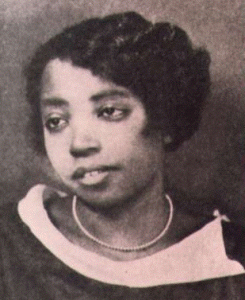I’m reading Frye Street & Environs: The Collected Works of Marita Bonner. Marita Bonner was a writer of the Harlem Renaissance who graduated from Radcliffe in 1922, moved to Chicago, and wrote a series of stories about a street of immigrants and African-Americans and their social dynamics. The short stories are pretty great, though very depressing, as the characters mostly come to bad ends; jail, the electric chair, social diseases, suicide, murder, soul-crushing poverty, rape, prostitution, adultery, boyfriends and husbands killing cheatin’ women, heart attacks from overwork, and a lot of babies who don’t get very good babysitters & grow up on paregoric syrup. They’ll definitely stick in my mind.
Here’s a list of the stories and plays:
On Being Young–a Woman–and Colored.–The Young Blood Hungers.–The Pot Maker: A Play to Be Read.–The Purple Flower.–Exit, an Illusion: A One-Act Play.–The Hands: A Story.–The Prison-Bound.–Nothing New.–One Boy’s Story.–Drab Rambles.–A Possible Triad on Black Notes.–Tin Can.–A Sealed Pod.–Black Fronts.–Hate is Nothing.–The Makin’s.–The Whipping.–Hongry Fire.–Patch Quilt.–One True Love.–On the Altar.–High-Stepper.–Stones for Bread.–Reap It As You Sow It.–Light in Dark Places.
I didn’t so much love the plays; not my thing. But it was interesting to read her stage and casting instructions which depend so heavily on casting someone of exactly the right shade of dark or light or bronze to express their character. A lot of the characters would fall into the category of “tragic mulatto”. Basically if you’re light with blond hair and violet eyes in a Bonner story, you’re out of luck and probably have several Social Diseases along with your silk dresses and bath salts (for the women) or handsome chiseled features and natty suits (for the men). Bonner tells stories about black people criticizing and fighting with other black people over social class and education, keeping her harshest criticisms though for people who are trying to be up and coming but who mistake expensive stuff for the way to do it. Other characters like Lee in “Hate is Nothing” have a sense of aesthetics balanced with their education and morals. Lee, like so many of Bonner’s characters, wants some excitement and escape. She goes driving off into the night to the nightlife of Tootsville, but instead of meeting a bad end she gives a ride to a lady in distress, helps bail her daughter out of jail, and comes home to hash out some of her issues with her husband and mom-in-law. Lee likes “nice things” but they’re presented by Bonner as being refined and artistic — silk cushion covers and a fine china tea set from Lee’s grandmother. I was relieved that Lee got a happy (if melancholy) ending.
“Black Fronts” tells two stories of social class from three different points of view. in Front A an extended family struggles through the depression by going on relief, having three families under one roof plus taking in a boarder, while one of the sons tries to keep up his status of being a lawyer along with his partying wife, Rinky.
You know Rinky. The skin of civilization which covers the black worlds has been erupting her type for years…. no back – no middle – all front… Rinky was one of those still so bedazzled with their own fresh varnish of diction and degrees that they cannot discriminate between those born to the manor and those born to the gutter.
Bonner just cannot stand poor Rinky and her husband and their pretensions but she has some sympathy for their worries as they lie awake at night thinking over how they just spent their last $5 on a bohemian party for their friends with sandwiches and booze – how will they eat, or live, and what happens when their creditors demand to be paid up in full? Rinky frets awake about how to send a dollar home to her mother down south (though even as she worries it’s more about her social position in dispensing largess than about responsibility or concern.)
Front B has a top and a bottom story. The top is in the voice of a maid, Mrs. Jones, ironing some napkins and needling her employer for not being as generous or having as nice stuff as another lady she works for. As she irons she is abusive to the children she’s there to babysit and plots out how to steal some napkins and sugar and vanilla (for the church and baking for the preacher!) while seething internally with resentment at her employer for not being a white lady, for not taking care of her own kids and doing her own dirty work. Mrs. Jones thinks of it as shameful to work for another black woman. The bottom of Front B is the middle class black woman who employs Mrs. Jones on the phone with a friend and in her internal monologue, frustrated and trying to carve out a little time for herself in the day (and failing). She especially hates how Mrs. Jones criticizes her for not having enough nice things, then steals the nice things she *does* have. Front B was one of the best stories in this book, with the internal and external monologues of each character perfectly set and perfectly mixed.
The hard workers and penny pinchers don’t fare any better than the social climbers, either because they die from overwork, their babies die, they get raped by their white employers, or because while trying to save their kids from poverty, they interfere with the course of true love or hold their children back from ambition. Or if that doesn’t happen, their children grow up to be slutty teenagers who frequent pool-halls and then there is inevitably a knifing and someone fries in the electric chair.
I also admired “Drab Rambles” which has a short preamble on the basic damage to people of color in the U.S. done by racism. “I am hurt. There is blood on me. You do not care. You do not know me. You do not know me. You do not care. There is blood on me. Sometimes it gets on you. You do not care I am hurt. Sometimes it gets on your hands — on your soul even. You do not care. You do not know me. ” “A check-mated Hell, seething in a brown body.” The story is told in two unrelated portraits. The first is of a 50 year old coal shoveller, Peter Jackson, at a clinic because of his bad heart. The second is of Madie who is trying desperately to keep a job while she has a little baby (also named Madie) to look after. Problem is anyone who will employ her for more than 5 minutes wants to rape her.
Madie second was black brown. The baby was yellow. Was she now going to go job hunting or have a sister or brother to keep with Madie second?
Cold perspiration sent her shivering in the alley.
And Madie cursed aloud.
I can’t say I exactly liked “One Boy’s Story” but like the others it will stick in my mind. The little boy Donald lives with his mom who takes in sewing from the white women of the town. The local doctor, white, has an affair with his mom, which everyone but the boy knows about. At some point she tries to end it and another man shows up, who looks to be her previous boyfriend or sweetheart, but when he figures out the doctor is Donald’s father he freaks out and leaves. The doctor comes tomcatting around again while the little boy hears his mom freaking out. He hits the doctor in the head with a stone and then while hugging his mom and crying afterwards, the pin of her brooch goes into his tongue AND HE GETS GANGRENE AND HAS TO HAVE HIS TONGUE AMPUTATED and everyone is a little bit glad that he can now never tell what he did and how he killed his dad. The end? Man that was gross and depressing.
I’m curious now to read more about Bonner’s life and to look at the work of her and Georgia Douglas Johnson’s “S Street Circle” of writers. I felt a bit sad that she stopped writing and publishing in 1941. I respect how she didn’t just write about the problems she herself faced as a fairly middle class woman with an Ivy League education. She dove into all sorts of intersectional problems of race and gender and social class. Her stories are eloquent and masterful in language & character expression, definitely worth a read.
I got this book out of a free box outside a little branch library in West Oakland along with a lot of other cool classics of late 19th and early 20th century African American literature and felt a bit sad too that the library didn’t have room to keep these works.


my nigga
swagg
luv this cuddy locabebe lmao